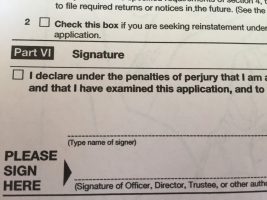Should You Use the 1023-EZ to Get Your 501(c)(3)?
Back in July of 2014, the Internal Revenue Service saw a need to address a growing backlog of applications for tax exempt status. Their solution was to introduce a new, shorter application (the 1023-EZ) aimed at small-revenue charity applicants. Although the 1023-EZ sounds like an organization’s dream, there are some drawbacks when compared with the original long form. Let’s take a look at some pros and cons, and determine if you may be eligible for this EZ form.
Eligibility to Complete Form 1023-EZ
- You are not eligible to use the 1023-EZ form if your organization:
- has received more than $50,000 in its previous three year existence.
- is projected to receive more than $50,000 in the next three years,
- has accumulated more than $25,000 in assets.
- was formed, or has a mailing address, outside of the United States.
- is a limited liability company (LLC).
- is a church, school, college, or university.
- has replaced a for-profit organization.
- is a private operating foundation.
- A complete eligibility worksheet can be found at the end of the Form 1023-EZ instructions at this link.
Rationale for Using Form 1023-EZ: Pros
-
Shorter and easier to complete
Instead of filling out the 26-page application, the new EZ application is only 3 pages. The IRS estimates that it takes 19 hours to complete this form. However, this is mainly due to preparation hours, which they consider will take up to 10 hours. If you’re prepared it should only take you 4-5 hours to complete. In contrast, the estimated completion time for the long Form 1023 is 105 hours.
The IRS estimates that it takes 19 hours to complete this form. However, this is mainly due to preparation hours, which they consider will take up to 10 hours. If you’re prepared it should only take you 4-5 hours to complete. In contrast, the estimated completion time for the long Form 1023 is 105 hours.
-
More rapid determination and notification of status
Normally the determination process can take anywhere from 6 months to a year and a half. With the 1023-EZ, the IRS gives you an approval or denial letter within 2-4 weeks of completing the application. We have even heard of organizations receiving notification within 3 days.
-
Less costly
Because the new application is fairly easy and self-explanatory, you will not have to hire legal counsel to assist with the form.
The filing fee for the 1023-EZ has been reduced to $275 as of July 1, 2016, whereas the filing fee for IRS Form 1023 is either $400 of $850, based on your organization’s projected income.
Basis Against Using Form 1023-EZ: Cons
-
Lack of IRS backing for donors
From the perspective of donors, the Form 1023-EZ process transfers the responsibility for attestation of appropriate organizational materials from the IRS to the signer of the Form 1023-EZ. IRS Revenue Procedure 2014-40 clearly states,
“a determination letter issued to an organization that submitted a Form 1023-EZ…may not be relied upon, if it was based on any inaccurate material information submitted by the organization.”
Inaccurate material is rather subjective in this instance, as this could pertain to your organization’s projections, exemption purpose, conduct of prohibited and restricted activities, or even organizational documents. Form 1023-EZ, does not provide the IRS with as much information as the original application does, so there is less verified information to make a determination on the attestations the signer made.
-
Signer Liability
There are numerous liabilities the signer of the 1023-EZ Form takes on because the statements and representations  made in the application fall under penalties of perjury should the statements be shown false.
made in the application fall under penalties of perjury should the statements be shown false.
For instance, the signer is accountable for any false information on the application. The signer also must attest to conditions he or she may not be qualified to fully understand. Some of these, but not all, include the verification of the organization’s charitable purpose, the existence of the proper founding documents, and that the founding documents contain the appropriate wording to ensure that the organization will be obeying laws regarding political activity, inurement of funds, and dissolution to name a few.
The form’s instructions do not mention any of these liabilities, only that the signer must check the box “penalty of perjury.”
-
Research Findings
The Taxpayer Advocate Service, (TAS) in its 2015 Report to Congress, stated,
“analysis of a representative sample of Form 1023-EZ applicants that obtained exempt status: 37% of the organizations in the sample did not satisfy the legal requirements for exempt status.”
In that same report, the TAS provides the following graphic showing that normally 95% of 1023-EZ applications are approved for exemption, however when the documentation is requested from a representative sample, only 77% of organizations are approved.
Should we be concerned that those running fully one-third of the 1023-EZ organizations are not aware of the requirements on 501(c)(3) organizations?
Boiling it Down
Generally speaking, the 1023-EZ application seems to best-fit smaller nonprofits looking to quickly get on the grid and not spend a huge sum of money. However, if you’re an organization who decides to go down this avenue, proceed with caution. This is a fairly new process, with some contradictions and confusing consequences. Perjury is as serious as it sounds. You will want to consult a knowledgeable source before proceeding.
 Contributed by Andrew Mengel
Contributed by Andrew Mengel
HSI Intern, Summer ’16
